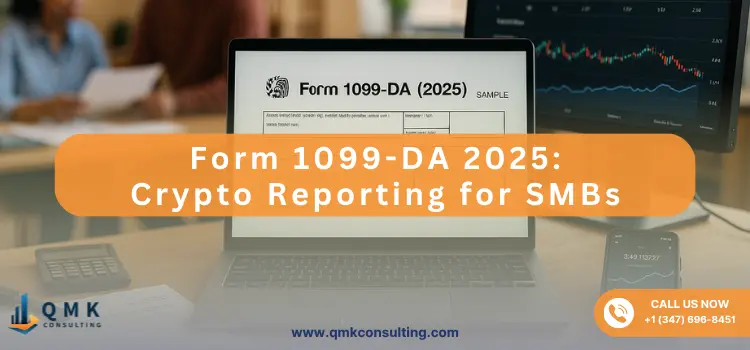
October 17, 2025 |Tax Preparation Services


More restaurants, franchises, and multi-location brands are touching digital assets—even if it’s just a supplier refund in USDC, a loyalty experiment, or selling a small stash of BTC to cover a new oven. Starting tax year 2025, there’s a new reporting layer you can’t ignore: Form 1099-DA. Below, I’ll break down what’s changing, what actually hits your accounting process, and how to stay clean with the IRS while protecting profit and cash flow.
The IRS finalized rules requiring certain brokers that facilitate sales or exchanges of digital assets (think crypto, stablecoins, some NFTs) to report your gross proceeds on a new form: 1099-DA. The regime applies to transactions occurring on or after Jan 1, 2025, with statements furnished to taxpayers shortly after year-end. In plain English: if you sell or exchange digital assets through a covered platform in 2025, expect a 1099-DA with the totals.
Who counts as a “broker”? The definition reaches beyond Wall-Street style exchanges. It includes digital asset trading platforms, payment processors, and certain hosted wallet providers that effectuate customer transactions. (DeFi is nuanced: current rules tilt toward interface-layer service providers; many purely non-custodial tools remain outside—for now.)
For 2025 transactions, brokers report gross proceeds—not cost basis or gain/loss. Basis reporting becomes the norm beginning with 2026 (with “covered” vs “noncovered” asset nuances, similar to stock 1099-B rules). Brokers must also furnish statements to you by mid-February (Feb 17 for 2026 season). Expect the first wave of 1099-DA forms to feel a lot like early 1099-B rollouts—useful, but incomplete without your internal records.
There’s transition relief as the industry spins up systems—especially around backup withholding and TIN workflows—so you’ll see the regime phase in. Don’t confuse “relief” with “no rules”; it simply lowers penalty risk while everyone gets compliant.
If you’re curious what the form looks like, the IRS has already posted a draft of the 1099-DA—it’s real, it’s coming, and it’s detailed.
It depends on how you touch crypto:
1) Separate revenue recognition from asset movement.
When you sell a burger for $25 and the customer pays in a stablecoin worth $25 at that moment, you still recognize $25 of revenue (plus sales tax, if applicable) in USD terms. The digital asset you received becomes inventory-like cash equivalent on your books. When you convert it later, you’ll realize a gain/loss compared with the value when you received it. (Gross proceeds on the 1099-DA will only show the sale side.)
2) Build wallet-level cost-basis records now.
Because 2025 forms won’t show basis, you must track it internally—by wallet and by asset. That means capturing:
Date/time received, USD fair value, and source (sale, refund, rebate, staking income, etc.).
Fees (network and platform) and method (FIFO, specific ID policy).
Conversion details when you sell or swap.
Starting 2026, brokers begin basis reporting for covered assets; you want your system clean before then to avoid zero-basis assumptions.
3) Map platforms to your ledger.
If your brand uses Toast for POS, Shopify for e-com, and a payment processor that auto-converts crypto, assign each to a sub-ledger. Post gross sales and break out fees, chargebacks, and conversion slippage to the correct accounts. That way, your P&L ties to bank/crypto wallets, and your 1099-DA totals tie to your disposal activity.
Decide your “crypto policy” (accept, hold, convert).
Clarify who owns the wallet.
Use business-owned wallets—never personal—so audit trails are clear. If you pilot DeFi or staking, route it through a controlled entity with documented approvals.
Update your AP/AR rules.
If you pay a vendor or contractor in digital assets, you’ve got two tax events to consider (your disposal + their income). Don’t wing it; codify this.
Train your finance team.
Walk through the 1099-DA form now so your month-end close anticipates what brokers will report—and your files contain what they won’t (basis, holding period, business purpose). (IRS)
“If I don't receive a 1099-DA, I don't have anything to report.”
False. Income and gains are taxable whether or not a form arrives. 1099-DA is third-party reporting, not your tax return.
“Basis reporting will fix my records.”
Not in 2025. You still need a complete internal basis to compute gain/loss; basis reporting becomes the norm starting in 2026.
“DeFi means no rules.”
The line is moving, but interface-layer providers can be treated as brokers under current regs. Design your processes as if reporting could expand.
QMK Consulting is an accounting firm in New York City, specialized in franchise accounting and restaurant accounting. We help operators build month-end workflows that stand up to 1099-DA: wallet-level basis, platform tie-outs, clean gain/loss reporting, and policies that won’t break your team or your brand guidelines. Then we convert clean data into decisions—pricing, labor, menu mix, and capex timing—so your cash flow benefits from compliance instead of fighting it.
If you’re expanding or exploring digital assets (even lightly), our team will design a right-sized process and train your staff so tax season is boring—the way it should be.
👉 Get your free profit & cash flow analysis by our experts.